Thousands of toes saved, one foot at a time. That should be Forty Below LTD’s motto with their long history of providing well made neoprene overboots to arctic sloggers and high altitude mountaineers.
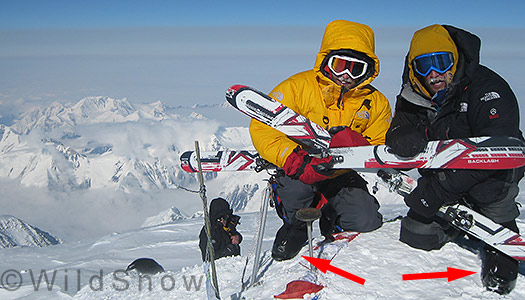
Tyler and Colby in their 40 Below overboots, summit of Denali. Using this model required removing the overboot to work well in ski bindings, but new Fresh Tracks model works much better.
Ski alpinists also use Forty Below overboots, but models made for climbing boots are hard to zip over ski boots. More, they have too much material thickness in the toe area to work well with tech style (e.g., Dynafit) backcountry skiing bindings. Thus, the common strategy for skiers using thick neoprene overboots has been to wear them on the crampon climb ascent, but strip them for skiing. Not good, since you’re removing your foot protection while still in a harsh environment. In that case, if something happened to delay your descent you’d be stuck without your overboots on, perhaps trying to put them back on in adverse conditions. (Yes, with some effort and experience it is possible to wear the thicker overboots in a variety of ski bindings, but in our experience doing so is much less than ideal.)
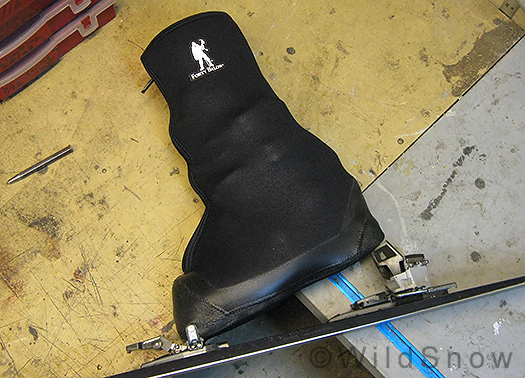
Forty Below Fresh Tracks overboot in Dynafit backcountry skiing bindings. They work.
Not one to rest on his laurels (even if he does like resting by his fire ring in his back yard with full view of Mount Rainier), Forty Below designer/owner Joel Attaway has stepped up and designed a neoprene overboot specifically for backcountry skiers and ski alpinists.
My Fresh Tracks overboots arrived recently, follow along while I fit to my daily go-to Dynafit rig. Purpose: No, I’m not headed to the Karakorum any time soon — just rigging for warm feet at trailheads and during cold snowmobile approach rides.
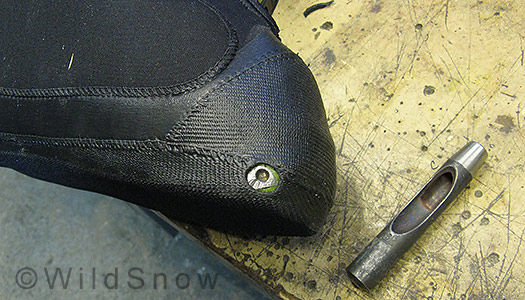
I cut the tech binding toe holes using a punch for a nice circular hole. You can do it with a razor blade as well. Just start small and keep it accurate. Locate fittings by probing with a sharp object.
The body of the Fresh Tracks is made of nylon covered 4.7 mm neoprene, with two layers of heat reflecting titanium. Key to performance in ski bindings is the overboot sole, which is the same stuff by only 2.5 mm thick so it works with Dynafit bindings and also makes it easier to clip in to toe-wire type bindings such as the Silvretta 500. (Critical areas of the toe and heel also use the thinner material, to help with ski and crampon bindings.) To prevent damage, the lower inside “instep” area of the overboots has a large patch of heavy duty Cordura nylon.
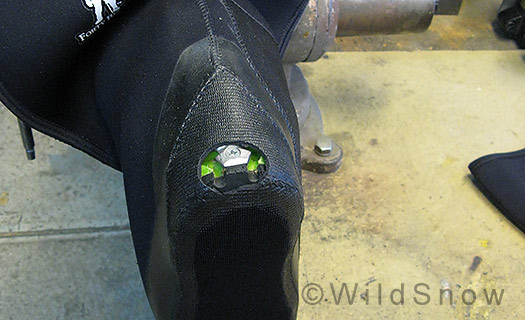
Cutout for Dynafit heel fittings. It's tough to get this looking 'factory' but it is really quite forgiving. Again, START SMALL and enlarge the hole as needed. It's more important to provide room at the lower side of the cut, for the heel pins to enter, than it is to have it larger at the top or sides. Once the tech binding heel pins enter the boot fitting, they'll push the overboot fabric out of the way. The pictured hole is probably too large on the top and sides, but the bottom is just about right.
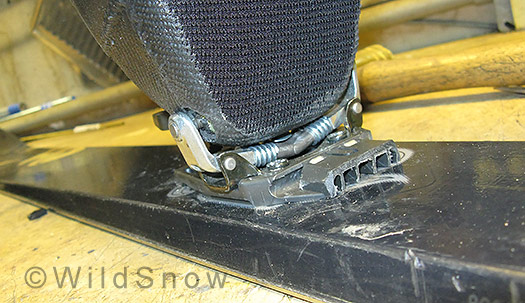
Dynafit binding clearance. With thicker overboots, it's clearance in this area that can give you trouble. The Fresh Tracks work fine once you're in the binding, but the fabric of the boot makes it hard to see the tech fittings when you're stepping into the binding, so you have to get used to taking a bit more care while clicking in.
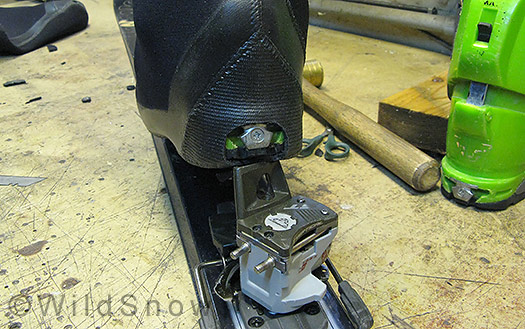
Overboot heel in climbing mode. While the Fresh Tracks overboot has the amazingly durable and grippy sole that Forty Below is known for, I suspect this will be a wear point for folks who use the overboots a lot. Solution is probably to just watch for wear and apply coating such as Shoe Goo or Seam Grip as needed.
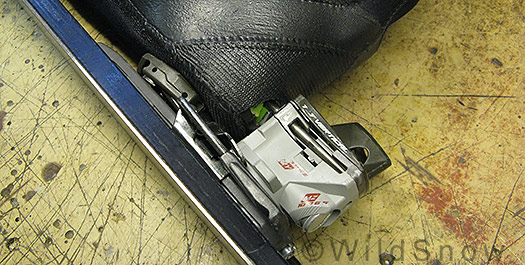
Heel in downhill mode, clicked into Dynafit tech binding. I didn't see any problems in this, but did notice that if I put my overboots on during the climb with boots on my feet, rather than back at camp or trailhead where I could carefully put the overboot on before putting my boots on my feet, I had trouble getting the toe and heel holes to line up well.
I can see seeral uses for Fresh Tracks overboots. Obviously, they’ll be terrific for high altitude ski mountaineering such as that on Denali, Logan, or overseas. But perhaps more importantly, it’s not uncommon for backcountry skiers to struggle with cold feet no matter how well they fit their ski boots and use tricks such as foot warmers and such. If you fall into that group, I strongly suggest you give overboots a try for colder days. Yes, it’s an extra step in the day and extra gear to fiddle with, but warm feet can be the key to the perfect day.
Shop for 40 Below overboots here.
WildSnow.com publisher emeritus and founder Lou (Louis Dawson) has a 50+ years career in climbing, backcountry skiing and ski mountaineering. He was the first person in history to ski down all 54 Colorado 14,000-foot peaks, has authored numerous books about about backcountry skiing, and has skied from the summit of Denali in Alaska, North America’s highest mountain.
